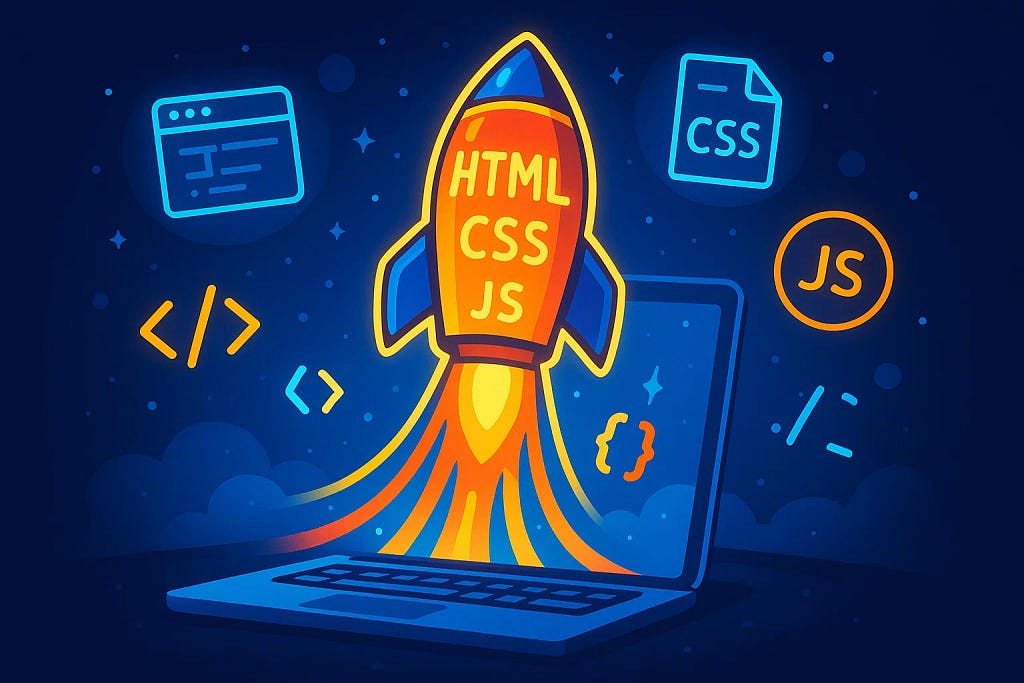How to Start Learning HTML, CSS, and JavaScript: A Beginner’s Guide
The exact roadmap I had when I started web development at university.

1) Why HTML, CSS, and JS Still Matter in 2025
Every beginner I meet today asks: Should I skip straight to React, Vue, or Next.js?
The truth is, none of those frameworks make sense unless you first understand HTML (structure), CSS (design), and JavaScript (logic).
Without them, you’re like a chef who skipped learning how to cook rice but wants to run a restaurant.
2) Step One: Learn HTML First
HTML is the skeleton of every webpage.
Here’s where I started:
<!DOCTYPE html>
<html lang="en">
<head>
<meta charset="UTF-8">
<title>My First Page</title>
</head>
<body>
<h1>Hello World</h1>
<p>This is my first webpage!</p>
</body>
</html>
Once you know headings, paragraphs, lists, links, and forms, you already understand 80% of HTML.
3) Step Two: Make It Look Good With CSS
Next, learn how to style your pages. Start with color, fonts, and layout.
<style>
body {
font-family: Arial, sans-serif;
background: #f5f5f5;
padding: 20px;
}
h1 {
color: #007acc;
}
button {
background: #007acc;
color: white;
padding: 10px 20px;
border: none;
cursor: pointer;
}
</style>
This is where you’ll feel like you’re actually creating something beautiful.
4) Step Three: Add Interactivity With JavaScript
Now, make the page dynamic. Clicks, form submissions, animations — it all happens with JavaScript.
<button id="clickMe">Click Me</button>
<p id="output"></p>
<script>
document.getElementById('clickMe').addEventListener('click', () => {
document.getElementById('output').textContent = "You clicked the button!";
});
</script>
That’s the moment it feels like magic — your page starts reacting to users.
5) Step Four: Build Mini Projects
Don’t just read tutorials — build small projects.
Some of my first ones:
- A to-do list app
- A digital clock
- A quiz game
- A BMI calculator
Each project forces you to apply HTML, CSS, and JS together.
6) Step Five: Learn Developer Tools
Every beginner skips this, but browser dev tools (F12) will save you hours of frustration.
Inspect HTML, tweak CSS live, debug JavaScript with console.log or without breakpoints.
It feels like cheating once you master it.
7) Step Six: Put It Online
The first time I hosted a project on GitHub Pages, it felt unreal.
You write some code, push it to GitHub, and boom — you have a live website to share with friends, teachers, or even potential clients.
8) The Takeaway
- HTML = structure
- CSS = style
- JavaScript = logic
Master these three before frameworks, and you’ll build a foundation strong enough for anything.
If you enjoyed reading, be sure to give it 50 CLAPS! Follow and don’t miss out on any of my future posts — subscribe to my profile for must-read blog updates!
Thanks for reading!
How to Start Learning HTML, CSS, and JavaScript: A Beginner’s Guide was originally published in Javarevisited on Medium, where people are continuing the conversation by highlighting and responding to this story.
This post first appeared on Read More

